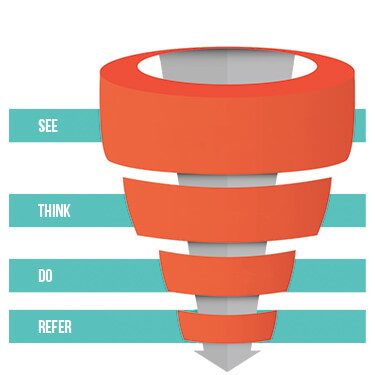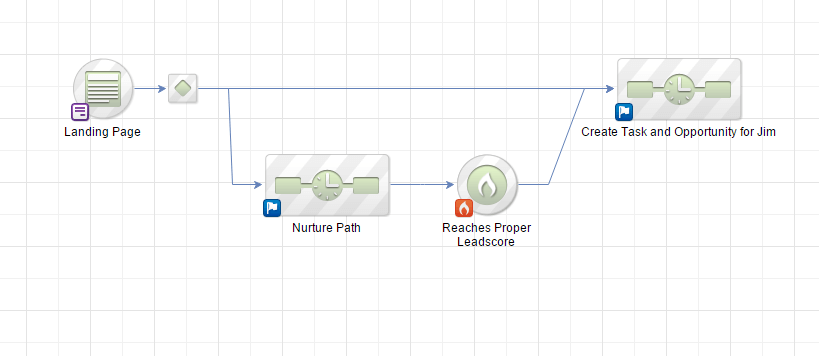There are very few tools available for small business that combine both sales CRM and marketing automation in one tool. Infusionsoft is a wonderful platform for allowing small businesses to do what, until recently, only large businesses with huge budgets could do. The ability to have both the sales and marketing data in one location is a huge time-saver and benefit to any business, especially a small business where employees are often wearing multiple hats.
The Problem
There’s a problem though. Aligning sales and marketing can be difficult. As a business grows, sales teams and marketing teams start to take on their own identities. What used to be the same person are now separate people or even separate teams of people. This is an issue I’ve seen across several growing businesses who use Infusionsoft.
To add fuel to the fire, marketing people and sales people are very different. Good marketers usually love good data and systems while good sales people are more concerned with numbers and people. The issue here is getting both teams on the same page. Marketing and sales should speak the same language, communicating the same message throughout the buying cycle or you’re left with frustrated prospects.
Contact Records vs Opportunity Records: Which one to use?
In Infusionsoft, there are two types of records for prospects: A contact record and an opportunity record. It can get confusing, but I like to think of it like this; Anyone who’s anyone in your database needs to have a contact record. This includes not only leads, but customers, strategic partners, vendors, your mom and brother and anyone else you can think of.
On the other hand, only qualified prospects should have an active opportunity record assigned to them. The opportunity record represents the stages a sales person will take that particular lead through to the sale. It’s important to note that an opportunity should never exist without a corresponding contact record while a contact record can certainly exist without an opportunity record.
For a more detailed overview of the opportunity records and module inside Infusionsoft, take a look at this article from Monkeypod Marketing.
As a general rule of thumb, marketing should be primarily concerned with the contact record and the data stored therein, while sales should be primarily concerned with the opportunity records. This isn’t 100%, but will get you started.
In a healthy business, the marketing team delivers qualified leads to the sales team (tweet that). Therein is the beauty of Infusionsoft’s tracking and automating abilities. But sometimes the message gets missed or the lead isn’t ready to talk to a salesperson or worse, a sales person isn’t notified of a qualified prospect.
The Hand-Off
So the question becomes, “When should you create the opportunity record in Infusionsoft?” In other words, “When should marketing hand the lead over to the sales team?”
The answer depends on your individual sales cycle and process, but I’ll provide a formula and some examples to work this out.
I like to think of sales and marketing as a system. I follow this process:
A Model to Follow
A typical buyers journey goes through these 4 steps: See, Think, Do, Refer.

The prospect sees an offer, often referred to as ‘awareness’. Then, they think about it, weighing it with other options and solutions, often referred to as ‘consideration’. Lastly, they decide to do whatever it is we’re asking them, often referred to as ‘decision’.
You can learn more about this methodology to building marketing campaigns here. I’m aware that not every marketing campaign can follow the exact same model, but it does provide a nice graphic to look at ;). In this post, I’m only referring to the “think” stage.
Thinking About It
This is the stage where a prospect ‘raises their hand’ and begins to evaluate the brand or offering. This is also the stage where the opportunity is created. Depending on sales cycle and product, someone might be in this stage for hours, weeks or even months. If your business has a longer sales cycle, weeks and months, it’s generally best to hold off on creating the opportunity record right away so your sales pipeline doesn’t get clogged with uninterested prospects. Use this time to cultivate the lead with additional marketing information and allow the lead to show you they’re interested.
Use infographics, white papers, videos and other collateral for the prospect to consume. This is where implementing a solid lead-scoring strategy is a huge win for sales teams. Learn more about setting up lead-scoring here. Once a lead has reached a certain level or taken a certain action, that you believe is the ‘tipping point’, then create the opportunity record and hand them off to a salesperson to start the sales process. This goes back to marketing’s job of only handing over ‘qualified leads’ to sales, rather than just every lead that comes through the door. This allows the sales team to be more effective in working more qualified leads.
A ‘Real-life’ Example
Take this scenario for example. Jim is a busy sales person at Dunder Mifflin, a paper company. Their website used to have just a single phone number for sales, which would get routed directly to him. Jim closed about 30% of the leads that called in. The other 70% were either price shopping or looking for a specific product not offered by Dunder Mifflin. Needless to say, he wasted a lot of time on the phone talking to unqualified prospects.
After implementing Infusionsoft and a marketing plan, Dunder Mifflin now collects prospect’s information from lead capture forms on the site and advertising landing pages. Based on how the prospect answers one or two basic questions, the lead is sent down one of two paths; a nurturing path or a sales path. The questions act as qualifiers and let Dunder Mifflin know how far along the prospect is in his or her buyer journey. Other examples include, “When are you looking to sell your home?” for Real Estate professionals or “What is your budget for this project?” for contractors. The point is to gage where the prospect is.
The sales path creates the opportunity record and gives Jim a task to follow up right away. The sales process begins.
The nurture path sends the prospect down a rout with additional product information (a series of 5 infographics, whitepapers and videos) that nurtures the prospect towards the sales path. Once the prospect has downloaded any two of the marketing resources, the opportunity is created, Jim is notified and the sales process begins.
Dunder Mifflin’s Infusionsoft campaign looks something like this:

No two businesses are alike
Of course, not every sales process is so rigid and linear. It would be great if every lead did exactly what we wanted them to do, but that’s just not the case. It’s also important to note that some businesses don’t have very many leads coming through their pipeline. If this is the case, then moving the opportunity creation earlier in the funnel is a good idea.
Following this framework should allow you to create a more defined marketing and sales process for your team.
Is there something I missed? How does your team align the sales and marketing processes?

